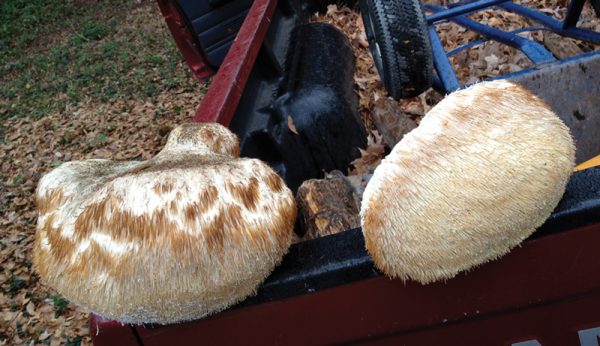
For most edible mushrooms, the only tool that you’ll need will be a pocketknife to cut the stalk. For the round, white tufts of a lion’s mane, however, you’ll want to add a ladder or a pole pruner.
Because while money doesn’t grow on trees, these gourmet mushrooms do. And sometimes you’ll have to crane your neck to see them.
For one 33-pound lion’s mane mushroom (the record is 100 pounds), I had to carry my 8-foot stepladder through the woods. I only kept 4 pounds of that mushroom and sold the rest to five downtown chefs.
I made $351 in less than two hours.
Mane Reasons
Lion’s mane mushrooms (Hericium erinaceous) can’t penetrate bark, so they grow from damaged areas on oak trees: broken limbs, hollows, lightning scars, cutoff stumps.
Rarely, I’ve harvested them at chest-height or even ankle-height. And they sometimes grow on city trees.
Read more: Why start foraging? It provides a link to ancient ancestors, for starters.
Lion’s Man Tales
One year, before speaking on foraging at a downtown organic farming conference, I strolled outside to psyche myself up. In the outdoor dining area of a restaurant, I found a 3-pound lion’s mane just out of reach on an oak tree. Ignoring the raised eyebrows of wait staff and diners, I borrowed a chair to stand on so I could wrench that mushroom from its hollow.
I passed it around at my presentation just a few minutes later.
Another year, I harvested a 6-pounder. I really wished I’d had that tall ladder with me then, as I had to make do with a borrowed 4-foot stepladder stacked on two borrowed plastic tote boxes full of Christmas decorations. And even on top of that leaning tower,
I could only pop that lion’s mane off the tree by spearing it with a pitchfork.
That’s foraging.
Worth the Hassle
But once the succulent, white flesh had been hand-shredded and fried up as a blue crab meat substitute in a crab cake recipe served to my wife and friends, all the airborne acrobatics were well worth it.
In the North, if it’s cool enough, lion’s mane can be found in summer and fall. But in the South, it’s most often found in winter—a good reason to adopt my preferred name for it: Santa’s beard.
It’s one of the best-tasting mushrooms. And one of the most medicinal.
These distinct mushrooms don’t have any poisonous lookalikes. They are bright white and completely covered with tender, white spines as long as almonds and as dense as fur. Hence, they get a lot of common names: bear’s head, goat’s beard, deer tail and pom poms.
Older ones may have a tawny tinge that doesn’t affect the flavor. The interior should be bright white, though. Any discoloration means it’s too old.
Read more: Want stories like this delivered to your inbox? Sign up for our newsletters today!
How to Use
If the weather has been dry, your lion’s mane may also be very dry and tough. In that case, let it soak in some water for 5 to 20 minutes, checking it with a squeeze until it has rehydrated to a palatable texture before cooking as described later.
If it’s been rainy, it may be so saturated that water will run down your arms when you harvest it. In that case, before cooking it, twist the mushroom like a sponge over a bowl to release the excess moisture until it’s tender but not soggy.
An amazing amount of water will come out, yet the mushroom will return to its original shape—like a sponge.
Save the liquid for cooking rice or starting a soup. Shave off the spines with a sharp knife, and cook them in butter or bacon fat for a few minutes and serve as a miniature pasta appetizer. Then, hand-shred the bulk of the mushroom to prepare for cooking.
You can add it to soups, sauces and stews. Or you can use it as a substitute for crabmeat. (It looks very similar when hand-shredded.)
You can even season and sauté it until browned as a stand-alone substitute for a meat dish.
After the leaning-tower-of-Christmas-decorations experience, I decided to carry my folding ladder in the bed of my pickup during lion’s mane season. I’ve used it twice. But I’m thinking that maybe a simple pole pruner would be lighter and perhaps safer.
This article originally appeared in the November/December 2020 issue of Hobby Farms magazine.




